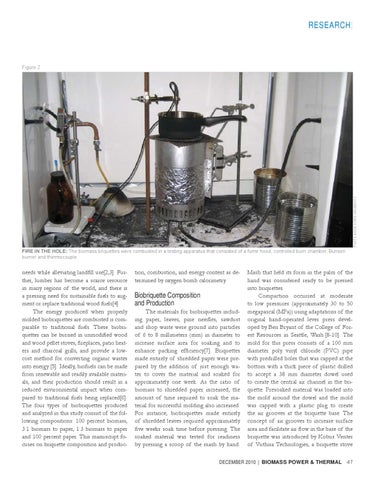RESEARCHÂŚ
PHOTO:BOISE STATE UNIVERSITY
Figure 2
FIRE IN THE HOLE: The biomass briquettes were combusted in a testing apparatus that consisted of a fume hood, controlled burn chamber, Bunsen burner and thermocouple.
needs while alleviating landfill use[2,3]. Further, lumber has become a scarce resource in many regions of the world, and there is a pressing need for sustainable fuels to augment or replace traditional wood fuels[4]. The energy produced when properly molded biobriquettes are combusted is comparable to traditional fuels. These biobriquettes can be burned in unmodified wood and wood pellet stoves, fireplaces, patio heaters and charcoal grills, and provide a lowcost method for converting organic wastes into energy [5]. Ideally, biofuels can be made from renewable and readily available materials, and their production should result in a reduced environmental impact when compared to traditional fuels being replaced[6]. The four types of biobriquettes produced and analyzed in this study consist of the following compositions: 100 percent biomass, 3:1 biomass to paper, 1:3 biomass to paper and 100 percent paper. This manuscript focuses on briquette composition and produc-
tion, combustion, and energy content as determined by oxygen bomb calorimetry.
Biobriquette Composition and Production The materials for biobriquettes including paper, leaves, pine needles, sawdust and shop waste were ground into particles of 6 to 8 millimeters (mm) in diameter to increase surface area for soaking and to enhance packing efficiency[7]. Briquettes made entirely of shredded paper were prepared by the addition of just enough water to cover the material and soaked for approximately one week. As the ratio of biomass to shredded paper increased, the amount of time required to soak the material for successful molding also increased. For instance, biobriquettes made entirely of shredded leaves required approximately five weeks soak time before pressing. The soaked material was tested for readiness by pressing a scoop of the mash by hand.
Mash that held its form in the palm of the hand was considered ready to be pressed into briquettes. Compaction occurred at moderate to low pressures (approximately 30 to 50 megapascal (MPa)) using adaptations of the original hand-operated lever press developed by Ben Bryant of the College of Forest Resources in Seattle, Wash.[8-10]. The mold for this press consists of a 100 mm diameter poly vinyl chloride (PVC) pipe with predrilled holes that was capped at the bottom with a thick piece of plastic drilled to accept a 38 mm diameter dowel used to create the central air channel in the briquette. Presoaked material was loaded into the mold around the dowel and the mold was capped with a plastic plug to create the air grooves at the briquette base. The concept of air grooves to increase surface area and facilitate air flow in the base of the briquette was introduced by Kobus Venter of Vuthisa Technologies, a briquette stove
DECEMBER 2010 | BIOMASS POWER & THERMAL 47
